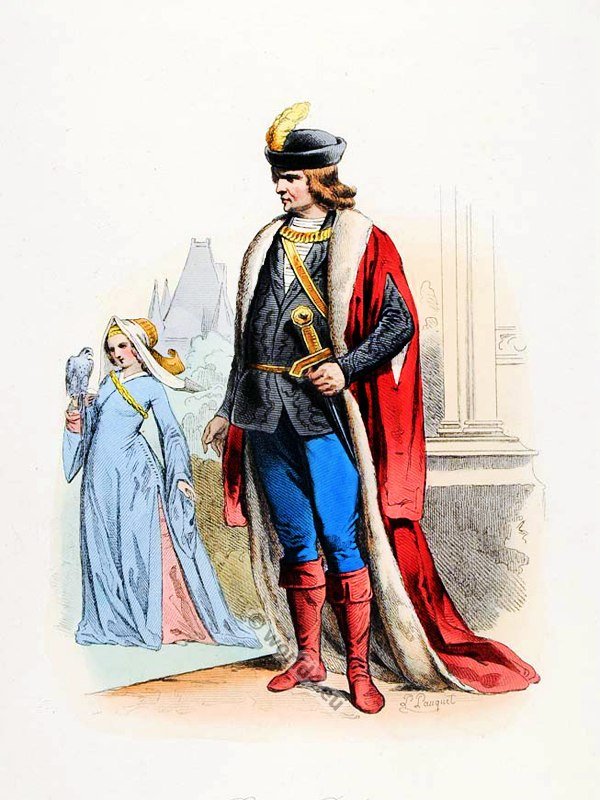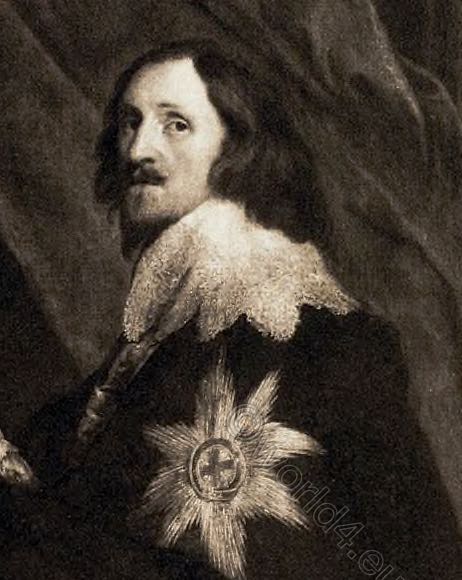
SIDNEY, FIRST LORD HERBERT OF LEA.
56 in. H. 44 in. W. Canvas. Sir Francis Grant, P.R.A. Smoking Room. Wilton House.
Sidney Herbert, 1st Baron Herbert of Lea (16 September 1810 – 2 August 1861).
Three-quarter length, standing facing the spectator, head turned slightly to his left; wearing a black frock coat, full black cravat, and doeskin trousers. The left hand, holding a high silk hat, rests on his hip, the right, extended, holds a walking stick. Background of open down country.
This is probably the portrait painted in 1847, and exhibited at the Royal Academy the same year (No. 510), the replica of which is now at Herbert House. At the time it was painted Herbert was thirty-seven, and had just relinquished the office of Secretary at War which he held in Sir Robert Peel’s ministry. He is wearing the watch and chain given to Elizabeth, Countess of Pembroke, by George III, the chain of which is now worn constantly by the present Earl.
Sidney Herbert, second son of George Augustus, eleventh Earl of Pembroke, by his second wife Catherine, daughter of Simon, Count Woronzow, was born at Richmond, Surrey, on the 16th of September, 1810. Like his father he was educated at Harrow School, afterwards matriculating at Oriel College, Oxford (17th May, 1828). While at the University he earned considerable reputation as an orator at the Union Debating Society, and although he refused to attempt “honors” in the final Schools, even when requested to do so by the examiners, he was granted an honorary fourth class.
Leaving Oxford in 1832, he entered the first reformed parliament that year as member for South Wilts, a seat which he held throughout his parliamentary career. His maiden speech, delivered in 1834, seems to have attracted the notice of Sir Robert Peel, and Herbert accepted from him the office of Secretary to the Board of Control, after refusing the offer of a lordship of the Treasury.
In Sir Robert’s second administration he was appointed Secretary to the Admiralty (August, 1841), a post which he held until January, 1845, when he became Secretary at War, with a seat in the Cabinet. Although at first Herbert was strongly in favor of Protection, Peel’s conversion to Free Trade seems to have altered his ideas, and he followed his leader into six years of official retirement.
In Lord Aberdeen’s administration (1852) he again accepted the responsibilities of Secretary at War, a position which he held during the Crimean campaign: it was entirely due to his official support that Miss Florence Nightingale *) was able to remedy the condition of the sick and wounded, a fact fully appreciated by Mr. Gladstone, who wrote in a letter to R. M. Milnes, afterwards Lord Houghton, dated 15th October, 1855: “I wish some of the thousands who in prose justly celebrate Miss Nightingale would say a single word for the man of ‘routine’ who devised and projected her going -Sidney Herbert.”
Incredible though it may seem, Herbert’s Russian family connection was quoted by his detractors as casting suspicion on his conduct of the war, and when the organization of the army broke down under the strain of protracted operations, he left the War Office and accepted office as Secretary of State for the Colonies in Lord Palmerston’s government (February, 1855). Unwilling to take advantage of his position when appearing before the Sebastopol Commission appointed to inquire into the conduct of the war, Herbert retired from office. The result of the inquiry was to exonerate him from any responsibility for the failure of the army organization, and to earn from Mr. Roebuck the following warm appreciation of his services:
“No man could have been more intent upon the honor of his country, and on performing the duties of his office. He was conscientiously endeavoring to perform his duty, and was always at his post.”
In 1859 he again essayed the superhuman task of remodeling the War Office at a time when the introduction of rifled ordnance was creating a revolution in armament, and the great wave of popular military enthusiasm, known as the “Volunteer Movement,” required the most exquisite tact and the finest administrative capacity to guide it safely through the sluices of official distrust. No man as conscientious as was Sidney Herbert could hope to carry through such a task without the aid of an iron constitution, and it was at this time that the symptoms of Bright’s disease began to show themselves. In spite of this warning he refused to leave his work, contenting himself with such relief from the strain of office as was afforded by his elevation to the peerage in 1860 as Baron Herbert of Lea. In the following year the progress of the disease forced him to resign, and he was taken to Spa. The rest came too late, and he died at Wilton House, 2nd August, 1861, three days after his return from abroad.
Sidney Herbert married on the 13th of August, 1846, at St. George’s Church, Hanover Square, Elizabeth A’Court, daughter of Major-General Charles Ashe A’Court, of Amington Hall, near Tamworth, brother of Lord Heytesbury. The Dean of Salisbury officiated, and the bridesmaids were: Lady Selina Meade, Miss Hamilton, Miss Bouverie, and the two Misses Vesey, daughters of Lady Emma Vesey.
By this marriage he had four sons and three daughters:
George Robert Charles, afterwards thirteenth Earl of Pembroke. Born 6th July, 1850, died 3rd May, 1895.
Sidney, present Earl. Born 20th February, 1853.
William Reginald, R.N. Born 21st May, 1854; lost at sea on H.M.S. Captain, 6th September, 1870.
Michael Henry, afterwards Ambassador to the United States of America. Born 25th June, 1857, died 30th September, 1903·
Mary Catherine, married Baron von Hügel.
Elizabeth Maud, married Sir Charles Hubert Parry, Bart.
Constance Gladys, married in 1878 St. George Henry, fourth Earl of Lonsdale, and, in 1885, Frederick, Earl de Grey, only son of the Marquis of Ripon.
Lord Herbert of Lea employed Thomas Henry Wyatt to build him the present Byzantine structure in place of the old Parish Church of Wilton.
Source: Wilton house pictures; containing a full and complete catalogue and description … by Sidney Herbert Earl of Pembroke. London, Printed at the Chiswick press, 1907.
*) Nightingale’s closest friends included the Herbert couple, whom she had met in Rome in 1850. Sidney Herbert held the post of Secretary of State in the British War Office in 1854 and was thus one of the most suitable people to support her in her planned mission. Her letter soliciting his support crossed with an official letter from Herbert to her, in which he asked her, as Secretary of State, to take charge of a group of nurses to travel to Scutari on behalf of the government. Herbert’s letter emphasised the experimental nature that this undertaking would have. Before the British army had left for the Black Sea, the use of nurses had been discussed but almost unanimously rejected by the army leadership.
Related
Discover more from World4 Costume Culture History
Subscribe to get the latest posts sent to your email.






